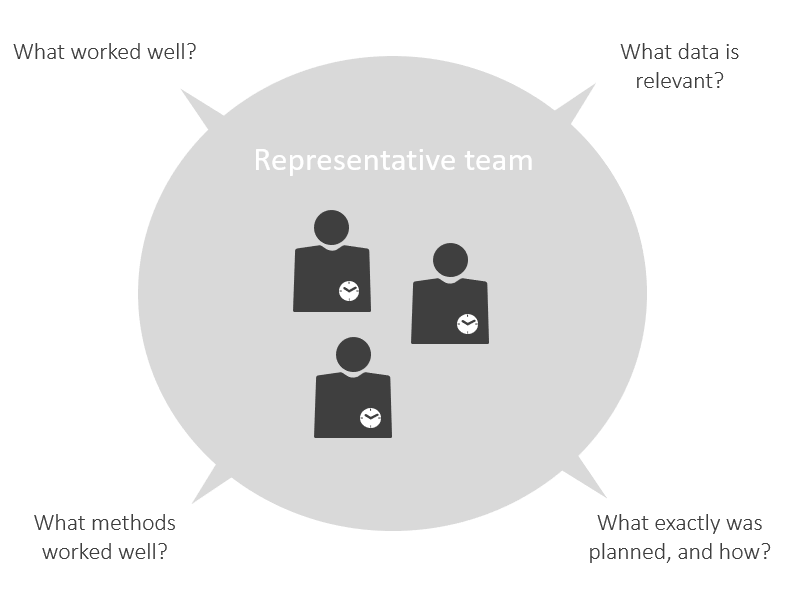This article illustrates the fastest way to introduce tactical resource planning at your company. Thus, it goes a step further than the article Resource Planning Tools for the Individual Roles which went into detail about the requirements for an optimal tool for tactical resource management.
You will be guided through the process in 6 detailed steps:
- Step 1: Promote the benefits
- Step 2: Start by planning for a first representative team
- Step 3: Conduct the first planning session
- Step 4: Introduce a coordination process
- Step 5: Regular operations and optimizing team planning
- Step 6: Introducing and optimizing project planning
- Conclusion
But let us first look at the meaning of resource planning.
Meaning of Resource Planning
By “tactical resource planning” we mean the coordination between project and line managers. It depends on the company’s form or organization (matrix or line). The goal is to meet the requirements for resources with the necessary skills for projects in a timely manner using staff from the line. This tends to be the team leaders’ task.
Only 2 Months to Arrive at a Useful Solution
Effective resource planning is the main desire of most companies seeking to implement a system for managing their projects and portfolios. However, for project managers, the focus ‒ at least initially ‒ is usually on PM methods, processes, and tools.
Resource planning is generally an afterthought. This is because resource planning is viewed as more difficult. Most people assume that, at least theoretically, good project planning is a prerequisite.
Resource planning is viewed as complicated because:
- Project managers themselves often find it difficult to know exactly who will be needed for which project and when
- It is difficult to get an overview of which employees, especially internal ones, are actually available.
But it depends on the benefit project management is expected to provide. It can actually make sense to introduce tactical resource planning in the beginning. In this case, project management is only introduced in a second step.
Special Download: 3 Important Points for your Tactical Resource Planning (PDF file)
Please fill in the form.
* Required Fields | Data Protection
Naturally, you will begin with project management, if detailed scheduling of projects has priority for you. And resource planning does not take center stage.
But you may be primarily looking for an overview of who works on what, and when. After all, only an overview of this kind allows you to assign projects and activities properly. In this case, we recommend the following approach: attend to the team leaders first and to the project managers afterwards.
Our tip: Do you require an overview of who works on what? And when? If you need this to be able to assign projects and activities properly, start with the solution for the team leaders. Then tackle the project managers next.
In our experience, the approach of focusing on the team leaders outlined below can be very fast. You may arrive at useful resource planning in only two months.
The figure below reveals the difference in time. You will reach your goal much faster with the overall planning of the resources by the team leaders. The detailed resource planning from the projects, albeit incomplete in total, takes considerably longer.

Reasons for the Difference in Time
What is the reason for this striking difference? These are the most important reasons:
- When introducing project management, you will have to establish several processes and methods which are unnecessary for tactical resource management.
- The number of project managers tends to be higher than that of team leaders. Thus, their training will take longer to begin with. What is more, they have to invest much more work into the detailed planning of their projects than team leaders into their overview.
- Projects have a start and a finish date. Team planning occurs without start and finish date month after month.
- It is not worth introducing a new system for projects that are almost completed. Hence, you transfer only long-running and new projects into the new system.
For these reasons, it will take many months to reach the desired situation. Eventually, you will get an overview of the resource utilization from the overall planning of many project managers. Yet, even this overall planning will only comprise project activities. Activities outside of projects are not taken into consideration.
This means that the resource utilization is still far from complete with the approach via the project managers. Yet, this is exactly what matters. For only a complete resource overview is useful. And this you can easily obtain from the team leaders.
Our tip: A resource overview is only useful when it is complete. The team leaders can actually provide one easily.
You can start complete resource planning in your teams any time. Besides absences and operations, you should consider all projects at least roughly at the highest level. Even without knowing the details at the level of tasks, you should be able to assign people to projects with a share of hours per month.
Team Leaders Should Know Their Team Members’ Responsibilities
As a rule, team leaders know what the members of their team are working on. At the very least, they know:
- In which projects they are involved
- When they are absent
- What other responsibilities they have
They may not always know the details, but their knowledge of the employees’ activities is comprehensive.
Without an adequate overview, the team leader will not be able to explain the team’s workload. For instance, he or she will struggle to clarify why a new project request will not fit into the team’s current resource utilization. This is despite the fact that this case tends to be one of the most important reasons for introducing resource management in the first place.
Free Download: How to Manage Tactical Resource Management (eBook)
How you make resource coordination between project and line management work smoothly: lots of practical tips and checklists on how to set this up quickly yourself (Processes & Tools).
To respond to questions of availability, team leaders do not need perfect and detailed planning. Chiefly, they require a complete overview of all resources and their respective activities. The team leader gains a lot by having more or less accurate answers to these questions. This is significantly better than a wrong answer.

It is a mistake to make commitments which cannot be kept. The usual reason is that activities were neglected when calculating the workload.
Apart from that, the team leaders’ planning almost always fluctuates except for vacation and a few regular meetings. After all, it is usually based on estimates.
The key difference lies in this: are you surprised that team members do not have time?
- Is this because they are pursuing activities the team leaders are unacquainted with? That is bad. You will need to work on your resource planning methods.
- Or are known activities simply taking longer than assumed? This is easier to justify.
Only Complete Resource Planning is Useful
Therefore, the primary objective is not necessarily perfect resource planning. What you need is complete resource planning. Resource planning only begins to be useful once it is complete. The initial complete plan can be refined in further steps.
Later, you can mainly improve one thing: the regular and increasingly more specific coordination with the project managers. The rest lies in the team leaders’ responsibility anyway. And soon it will also be available in the right system.
Our tip: What you require first is complete resource planning. It only begins to be useful once it is complete. Missing details can be added later to enhance its value.
Below, you will learn how to introduce tactical resource planning via the team leaders.
Step 1: Promote the Benefits

If you want to persuade the team leaders, you need to highlight the benefits of a central system for resource planning as follows:
- Decision-makers receive utilization overviews of all teams. As a rule, these are aggregated. Yet, the decision-makers have the option to “drill down” to every individual team. This provides them with all the necessary details to make informed decisions.
- Team leaders obtain valid utilization overviews. These enable them to achieve the best possible utilization of their team, without overload.
- Project managers obtain more reliable commitments regarding:
– the availability of suitable resources (in matrix organizations)
– delivery dates of results (in line organizations)
Do some marketing for the introduction of tactical resource management! Get the affected people involved. But watch out: be aware that you are also creating a transparency some team leaders may not be comfortable with.
Another interesting read: The Challenges of Tactical Resource Planning
Another important point is to reach an agreement with the employee organization / works council at an early stage, as they might suspect the possibility of unjustified surveillance of the employees. However, this should not cause any real problems, since:
- The users of the planning data are the team leaders
- These are the direct supervisors; and, for the benefit of their employees, they can now plan a better utilization
- The aim is to avoid overload; less overplanning means less stress for the employees
Our tip: Turn affected people into proponents. Thus, they will support you in advocating the introduction of a solution for tactical resource planning. And be aware that not all team leaders will appreciate this new transparency.
Step 2: Start by Planning for a First Representative Team
If changes are due, consider first: what has worked well in which area so far? What have team leaders been planning to date? And with how much detail?

Find out the resource planning methods and data that have been tried and tested and adopt them.
Look for Team Leaders as Proponents

Identify a known well-organized team. And make sure its team leader is willing to support your undertaking and resource planning methods. You need a template that can be used by everyone. Ideally, you will not start by creating this template in Excel. Instead, use a suitable resource management tool for team leaders. In this way, you point your colleagues in the right direction from the get-go.
Define the Granularity of Your Planning
Define the planning granularity in weeks or months. Planning in quarters tends to be too rough; days are usually too detailed. This mostly depends on the duration of tasks and the planning intervals.
Should planning occur in hours, days or FTEs (Full Time Equivalents)? This is also determined by the scope of the tasks. It may be better to enter the number of days than several hundred hours.
Wondering how to do resource planning? Find a few answers in this article:
Resource Planning in Project Management.
On the other hand, hours are always without ambiguity. In the case of part-time employees, days can raise the question how these are to be understood. FTEs are an attempt to bypass this question. The concept needs to be explained all the same.
Record Activities and Assign Categories
Define rows for absences. At best, these are vacation and other. As a rule, it is not permitted to enter illness. The employee organization / works council is particularly vigilant in this respect.
Define rows for general operations per team that apply to the majority of team members. These can be activities such as team meetings, further training, presales, support etc. Maintain these rows in the tool for all team members.
Identify the individual operations of each team member. In contrast to the general operations, these can change over time. And they must not concern the deliverables within projects.
Record all projects in which your team members are involved. Start with one row per project. You may not have any usable planning data from the projects. In such a case, begin by falling back on the team leader’s and the team members’ knowledge.
As repeatedly stated: mind the completeness of the activities more than the specificity. It is much more important to get an approximate overview specifying which projects are actually involved. But it is problematic to plan individual tasks in detail for some projects while others are not considered at all. Simply because some details are missing.
The point is to record everything to begin with. Thus, you obtain a complete picture, albeit your first draft.
Our tip: Mind the completeness of the recorded activities more than the specificity of your planning. It is important to obtain a complete picture for a start. Otherwise, your planning will include an unknown quantity of error. This is not conducive to reliable resource planning.
Based on this, you can establish coordination processes with the project managers. Thus, they stand on a better footing from the outset.
Involve the Project Managers Gradually
There is no need to involve all project managers at once. This can happen step by step.
Some projects are about to be completed. Planning them in detail is not worth the effort. Others may only start in a few months. In both cases, rough planning is sufficient. This can be because detailed planning may not be worth pursuing:
- yet
- anymore
But one thing is always wrong: not to plan something only because it cannot be as specific as you would like it to be.
Involve Further Team Leaders and Optimize the System Together
Present the result to the other team leaders and integrate their feedback. After all, every team leader has to:
- Understand the structure
- Accept the granularity of the planning
Step 3: Conduct the First Planning Session
Before defining the processes, ensure that the team leaders involved become familiar with:
- The tool
- The planning effort
Of course, you can also define the planning intervals first. And begin to populate the tool afterwards.
But in our experience, organizations tend to take on more than they can actually accomplish.
That is why it often makes sense to let all team leaders gather experience with the initial planning for their team. Only then, do you define the intervals at which you update the planning.
Are you working with Microsoft Project? Find out about the feature Resource Engagements.
A good system for this purpose has to be a simple system. Normally, a team leader should not need to spend more than two hours per week on team planning.
But the initial planning is bound to take longer. For the users have to:
- Familiarize themselves with the structures
- Get to know the tool
In addition, various data will not be as readily available as hoped-for.
Good Support of the Team Leaders is Vital
Ensure that the team leaders have good support. Planning has to be a positive experience for them from the start. Some will require more support than others will.
It is vital to convince as many team leaders as possible in the first round. They need to recognize the benefits of working with their own real data.
Our tip: At all events, ensure good support for the team leaders in the first few weeks. Planning has to be a positive, smooth experience for them from the start. And never stop communicating the benefits of working with their own data.
Possible Guidelines for Data Maintenance
Define steps to be completed when entering the data. The following entries are necessary:
- All team members and their capacities (ideally, the system will have been populated automatically for every team with the resources and their capacities; the data is derived from their work schedules)
- Absences and general operations (can possibly be imported from other systems)
- Individual operations of all team members
- All projects at team level (can possibly be imported from other systems)
- All project requests for team members (can possibly be imported from other systems)
- All project commitments for the coming e.g. 3 months
Choose Preliminary Intervals between Updates
Choose the update frequency that seems reasonable to you. Maybe, you start with a weekly interval.
Thus, you might obtain an initial overview of all teams showing the current status consistently.
Naturally, it will include overload yet to be resolved. But this will only work together and at the intervals you determine.
Next, it is necessary to coordinate the planning intervals. All involved have to be able to comply with them.
Step 4: Introduce a Coordination Process with Regular Planning Intervals
As mentioned above, we strongly advise you to introduce a regular process cycle at your company. And this has to be lived. For the requests from projects tend to change dynamically. But the team leaders cannot reschedule their team planning every day.
Therefore, it is necessary for the planning to be up to date by the due date. In the case of resource conflicts, all team leaders and project managers involved have the same current basis for decisions.
You should still get used to the fact that resource planning cannot always be 100 per cent specific. External interferences often come sooner than you can adjust your planning.
This is how you approach the introduction of regular planning intervals:
- Identify the parties involved in the process (project manager, team leader and the PMO).
- Come to an agreement with them as to which intervals are appropriate for resource coordination at your company. If in doubt, begin with longer intervals. This will allow you to actually complete the update.
- Ensure that the commitment of the resources is fixed for the current and the following interval. This is the only way to achieve a consistent resource utilization.
- Assist the project managers in updating their project plans in line with the agreed intervals. You always need the total current resource requirements for the same date.
- Coordinate the use of resources with the team leaders based on the current project planning.
- Resolve resource conflicts project managers and team leaders cannot eliminate in a steering committee. This committee should be made up of the respective decision-makers.
- In a multi-project environment, top management will first have to define the priorities in the course of strategic resource planning (also known as capacity planning).
Interested in the strategic side of resource planning? Read about PM Capacity Planning.
Special Download: Capacity Planning – 4 Important Success Factors (PDF file)
Please fill in the form.
* Required Fields | Data Protection
The figure below shows such a process cycle across the levels of the roles involved.

Step 5: Regular Operations and Optimizing Team Planning
Run through the planning cycle a few times. Once it is more or less stable, you can start optimizing it.
What is the situation at your company at this point in time?
- Have the promised benefits of the new resource planning materialized?
- Are team leaders, project managers and decision-makers working with better overviews? And can they use these as a basis for their decisions?
- Does everyone succeed in updating the plans on time?
- Are the coordination meetings successful?
It may be that:
- In some areas your planning was perhaps too rough
- In others it may have been unnecessarily detailed
The task at hand is to strike a balance between effort and benefit and optimize them. This can take several weeks or even months.
You could even implement some technical interfaces realized. These would enable you to synchronize data regarding capacities and absences automatically from HR systems. Or you may automate the interfaces between project planning and team planning.
Step 6: Introducing and Optimizing Project Planning
Up to now, you have advanced resource planning on the team leaders’ side. This has allowed you to achieve a complete overview quickly.
Now you need to advance the processes, methods and tools for project planning, too. The PMO is responsible for doing this.
If you are interested in this part you might want to look at our PMO Survey 2020 and download a free reading sample.
Conclusion – How to Introduce Tactical Resource Planning Quickly
In this article, you have learned how to introduce tactical resource planning in 6 steps. A few weeks will suffice to complete this process.
You are now familiar with the way in which you can reach the first goal of resource planning: a complete overview of all employees’:
- Capacity
- Workload
- Exact occupation
Careful preparation and the right plan will be necessary. And you will have to approach the introduction via the team leaders.
Our final tips
Get to know the individually adaptable “PPM Paradise” – the optimal environment for your enterprise-wide project, program, portfolio and resource management. Download the eBook now (just click, no form).
And sign up for our bi-weekly blog newsletter to make sure you receive all our updates.
What have been your experiences when introducing resource management? Are you still unclear on how to do resource planning? Or is there anything you would like to add? Please leave a comment below.
Subscribe to TPG BlogInfo: Never miss new practice-oriented tips & tricks
Every other week: Receive practical tips in TPG blog posts written by recognized experts in project, portfolio, and resource management.
* Required Fields | Data Protection
 Johann Strasser
Johann Strasser
Managing Partner at TPG
The certified engineer, has been a managing partner at TPG The Project Group since 2001. After many years as a development engineer in the automotive and energy sectors, Johann Strasser spent a decade as an independent trainer and consultant in the field of project management. During his tenure, he also served as project manager for software projects in the construction industry and provided scheduling and cost management support for large-scale construction projects. At TPG, he applies his expertise in product development and consulting services for international clients. His special focus is on PMO, project portfolios, hybrid project management, and resource management. For many years now, he has shared his knowledge through presentations, seminars, articles, and webinars.
Read more about Johann Strasser on LinkedIn and XING.
 Achim Schmidt-Sibeth
Achim Schmidt-Sibeth
Senior Marketing Manager
After earning his engineering degree in environmental technology, he gained many years of experience in project management through his work at an engineering office, an equipment manufacturer, and a multimedia agency. Achim Schmidt-Sibeth and his team have been responsible for marketing and communication at TPG The Project Group for many years now.











4 Comments
good information in this article
Thank you very much! Kind regards, Anna Pauels
Very helpful information. Question – when would you incorporate estimating the work effort into this process?
Dear Sheila,
could you please be a little more specific in your question? Then we will try to help you as soon as possible!
Have a great day
Anna Pauels